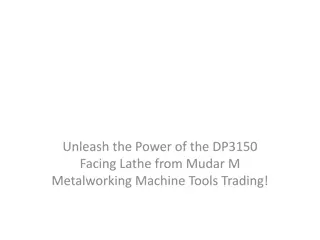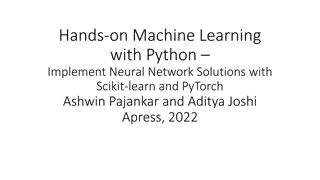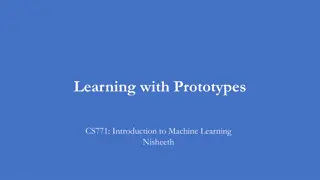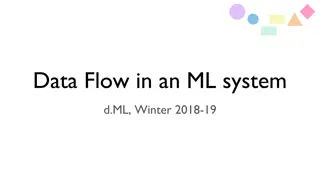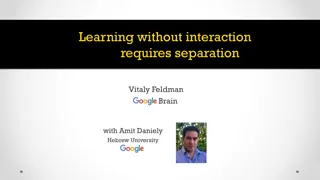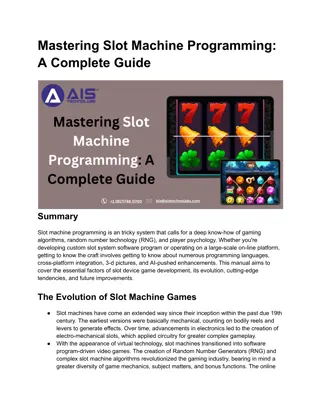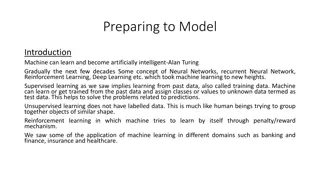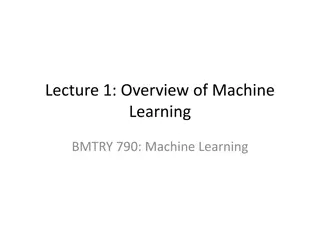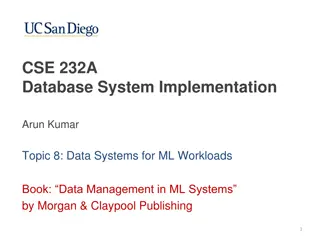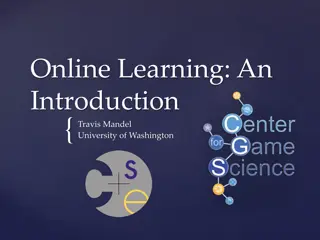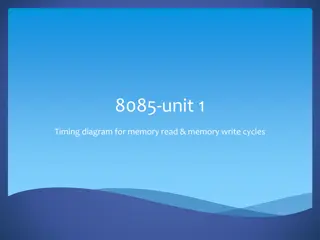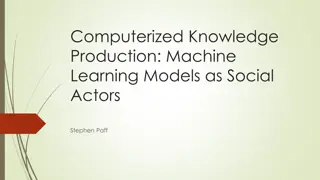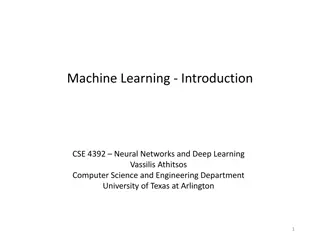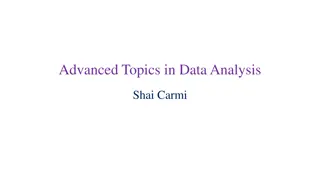Introduction to Advanced Topics in Data Analysis and Machine Learning
This content delves into advanced topics in data analysis and machine learning, covering supervised and unsupervised learning, classification, logistic regression, modeling class probabilities, and prediction using logistic functions. It discusses foundational concepts, training data, classification models, and the logistic regression process to determine probabilities and make predictions based on test data.
Download Presentation

Please find below an Image/Link to download the presentation.
The content on the website is provided AS IS for your information and personal use only. It may not be sold, licensed, or shared on other websites without obtaining consent from the author.If you encounter any issues during the download, it is possible that the publisher has removed the file from their server.
You are allowed to download the files provided on this website for personal or commercial use, subject to the condition that they are used lawfully. All files are the property of their respective owners.
The content on the website is provided AS IS for your information and personal use only. It may not be sold, licensed, or shared on other websites without obtaining consent from the author.
E N D
Presentation Transcript
Advanced Topics in Data Analysis Shai Carmi
Introduction to machine learning Basic concepts Supervised learning: classifiers o ?-nearest neighbors o The perceptron o Logistic regression o Measuring accuracy o Neural networks Unsupervised learning: clustering and dimension reduction
Supervised learning: classification Training data: ? = 52 Features: temperature, blood pressure (? = 2) Label: sick/healthy learning Sick Healthy ? ? ? Temperature ? Class separation line ? Blood pressure
Modeling class probabilities We would like to find a model for ? ? = Prob(Class A A|?) Prob(class A A|?) Class A Desired properties: ?(?) 1 when almost everyone is class A ?(?) 0 when almost everyone is class B When some are class A and some are class B, ?(?) 1/2 1 x x x x xxx x xxx o ?(?) o 0 xxx x x xxx x x x ? o Class B
The logistic function logistic(?) The logistic function is defined as logistic ? = 1+? ? logistic(?) is always in [0,1], so can describe a probability 1 Properties: o If ? ,logistic ? 0 (class A) o If ? + ,logistic ? 1 (class B) ?
Logistic regression Assume that the probability that ? belongs to class A is a logistic function of ? ? ?? = logistic ?0+ ?1??,1+ ?2??,2+ ????,? The coefficients ? are called weights For convenience, redefine ? = (1,?1,?2, ,??)and ? = (?0,?1, ,??) ? ?? = logistic ? ??
Logistic regression ? ? = logistic(??) We learn weights such that logistic ? ? best fits the training data Sick We use the likelihood to define the goodness of fit Using gradient descent, we find the weights with the maximum likelihood Healthy ? (test score)
Prediction ? ? = logistic(??) For a new ?, compute ? ? = logistic ? ? Sick We can use ? ? as the probability Alternatively, If ?(?) > 0.5, classify ? as class A If ?(?) < 0.5, classify ? as class B Actual data points sick/healthy? P(sick)=0.2 Healthy ? (test score)
Logistic regression is a linear classifier 1+? ? ?=1 1 The boundary between classes is ? ? = 2 This leads to ? ? = 0 for the boundary, which is linear in ? What to do about a non-linear boundary? Sick Healthy Temperature ? ? = 0 Blood pressure
Taxonomy of methods Parametric? Yes No K-nearest-neighbors Decision Trees (Random Forests, Boosting) Gaussian Processes Linear? Yes No Perceptron Logistic Regression Linear Discriminant Analysis Na ve Bayes Classifier Support Vector Classifier Neural Networks Support Vector Machines (some)
A graphical representation of logistic regression Neuron ? ? = logistic ? is the activation function (as in biological neurons) ??,0 Input feature #0 ?0 ?1 + Input feature #1 ??,1 Output, ? ?? = ? ? ?? ? ? Input feature #2 ??,2 ?2 ? ? = logistic(?) ?? ??,? Input feature #? ?
The neural network Neuron 1 + We add a layer of neurons Called the hidden layer logistic ??,1 + + Output, ? ?? logistic ??,2 logistic Neuron 2 Output neuron + ??,? logistic Neuron ?
The neural network Neuron 1 + ?1,1 logistic ?1 ??,1 ?2,1 + ??,1 + Output, ?( ??) logistic ?1,2 Output neuron logistic ?2 ??,2 ?2,2 Neuron 2 ??,2 The weight ??,? is the weight of input feature ? when it enters neuron ? The weight of hidden neuron ? is ?? ?1,? ?? ?2,? + ??,? ??,? logistic Neuron ?
Neural networks: intuition Non-linear decision boundary But can be represented using two linear classifiers ?2 x Are we above the red line? x x x o Neuron 1 o o o ?? + x logistic o o x + x Output, ?( ?) logistic ?? ?1 + Output neuron logistic Neuron 2 ?? X: Class A O: Class B Are we above the pink line?
Neural networks: intuition x2 x x X: Class A O: Class B xx oo ooox Are we above the red line? o Neuron 1 x x x0 + logistic x1 + Output, ?( ?) logistic x1 Neuron 2 Class A + Output neuron logistic 1 Neuron 2 xxx x x2 oo oo oo Are we above the pink line? Class B xxx 0 1 Neuron 1
The neural network Neuron 1 + ?1,1 logistic ?1 ??,1 ?2,1 + ??,1 + Output, ?( ??) logistic ?1,2 Output neuron logistic ?2 ??,2 ?2,2 Neuron 2 ??,2 ? ? = logistic ?1logistic ?1 ? + + ??logistic ?? ? ?1,? ?? ?2,? + ??,? ?1= ?1,1,?2,1, ,??,1 ??,? logistic Neuron ?
Neural network is a non-linear classifier ? ? = logistic ?1logistic ?1 ? + + ??logistic ?? ? The decision boundary is ?( ?) = 1/2 as before Because of the hidden layer, the boundary is non-linear Even with a single hidden layer, neural networks can implement very complex non-linear decision boundaries
Intuition Each input is sent to all neurons in the hidden layer, with different weights Neuron 1 + Each hidden neuron computes a different (linear) function of all inputs, representing higher-level features logistic ?? + Output, ?( ?) + logistic ?? logistic Neuron 2 Output neuron The output neuron computes the final output as a function of those high-level features + ?? logistic Neuron ?
How to train a neural network? List all weights as a single vector ? Define the objective function to minimize: 1 ? ?=1 ? 2 ??? , where ??? = ? ?? ?? ? ? = Training the network = find weights ? that minimize ? on the training set Then, classify a new point ? as class A if ? ? > 0.5 and class B otherwise
How to learn the weights? We find the optimal weights using stochastic gradient descent o Randomly initialize the weights o Choose a random data point from the training set, ??,?? o Update the weights: o ?? ?? ????? ???, for each ? o Repeat until reaching the minimum The derivatives can be computed efficiently using the backpropagation algorithm
Regularization The number of parameters in a network can be very large and lead to overfitting A useful approach to avoid overfitting is regularization We define a new objective function: ? ? = ? ? +? o ? is the number of weights and ? > 0 2+ ?2 2+ ?? 2 2?1 Minimizing the new objective will tend to set many weights close to zero, since otherwise the second term will increase This will have the effect of keeping the model simple The value of ? can be determined using cross-validation
Remarks In contrast to logistic regression, we may reach a local minimum Optimization can be slow, because of the large number of weights As for logistic regression, we need to fine tune the learning rate ? o Can try different values and use cross validation to see which works best o Can rerun from multiple starting points, and average the results or take the best model It is possible to use activation functions other than logistic
Neural networks: brief history Neural networks were popular in the 80 s, but went out of fashion in the 90 s Revived in the late 2000 s due to: o The availability of large amounts of labeled and unlabeled data o The increase in computing power and particularly, the affordability of GPUs o Theoretical developments that increased speed and accuracy Currently the strongest solution for prediction based on images, speech, and language, i.e., complex natural signals with high levels of non-linearity Milestone goals recently achieved (human-like performance) Recent developments fall under deep learning
What is deep? Having multiple hidden layers can improve accuracy The same feature (red) can be used multiple times Shallow network Useful for images, speech, etc., where features can appear repeatedly anywhere Deep network
Neural networks: advantages A neural network can represent any complex function (at the cost of more units) Unparalleled performance, success in problems thought to be impossible Neural networks learn the features automatically: the middle layers can be thought of as representing the features Feature engineering not needed! Specialized architectures guarantee that prediction is robust to small shifts or rotations of the features (e.g., in images)
Neural networks: disadvantages Usually impossible to interpret the inferred model: each input is used multiple times and non-linearly Can be a problem in medicine Can be very slow to train and requires large training sets Requires tailoring the architecture to the specific problem at hand, possibly with extensive cross-validation Many architectures possible, and expertise is required for network design


